
Summarize Content With:
Summary
This blog teaches us about the increasing significance of an API-first conversational AI platform, how it is different from the usual solution, key players and essential features that make such platforms more intelligent, quicker and more scalable for businesses.
Key Takeaways
- API-first design provides flexibility, scalability and rapid innovation.
- Customer interaction and productivity are changing drastically due to conversational AI.
- Promising technologies such as Botphonic AI, Dialogflow, and OpenAI have distinguishing features.
- These platforms are future-ready with core features like NLP, multilingual support, and analytics.
Introduction
Consider picking up the phone and talking to a business, not to a human, but to an intelligent AI call assistant that knows immediately what you want and responds to you with empathy and even makes appointments in real time. Or imagine an AI call centre having thousands of conversations every day without tiring it out.
This is not science fiction anymore. The emergence of an API-first conversational AI platform is transforming how companies engage clients. As opposed to legacy chatbot platforms that were fixed and were a pain to scale, the API-first nature of those platforms allows developers to create, tailor, and fit conversational AI to any application.
As businesses aim at smarter, faster and more scalable solutions, the transition from less monolithic, prepackaged bots to API-first ecosystems is becoming unavoidable.
What is an API-First Conversational AI Platform?
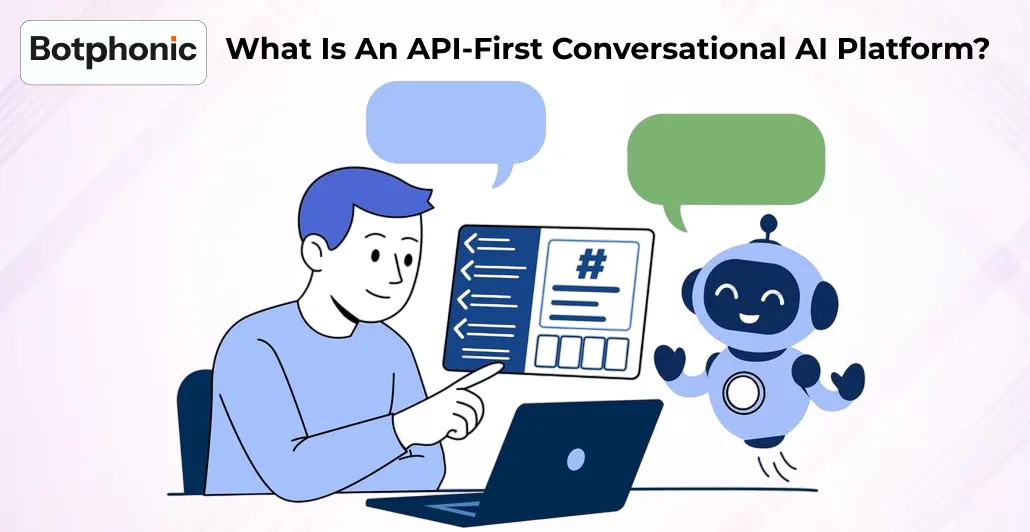
An API-first conversational AI platform is a platform built with APIs front and centre, not as an afterthought. That is, all functions, including natural language processing (NLP), call handling, analytics, and integrations, are available programmatically using APIs.
Why “API-first” is Shaping the Future of Automation:
- Versatility: An API can enable company owners to integrate conversational AI into tools, apps, and processes.
- Scalability: The expansion can be achieved seamlessly as the number of customers increases through API-first design.
- Quicker development: Engineers can rapidly test, iterate, and push features without waiting for monolithic releases.
Conversational AI’s Impact:
- Improves customer interaction by interacting in real-time personal discussions.
- Speeds up the work by automating repetitive queries.
- Enables scaling to deal with thousands of interactions at a time.
Major Players in the API-First Conversational AI Space
Here’s a quick overview of leading players that are shaping this space:
- Botphonic AI: It is a contemporary API-first conversational AI technology that supports great customisation and developer services.
- Google Dialogflow (Api.ai): The most common among NLP and cross-channel integration.
- Botpress: It is an open-source, developer-centric framework.
- IBM Watson Assistant: Enterprise-oriented and compliance-robust.
- Microsoft Azure Bot Service: High level of integration with the Microsoft ecosystem
- Yellow.ai: Provides customer engagement automation.
- Gupshup: Provides messaging and conversational AI at scale APIs.
Start your journey today with Botphonic AI and see the future of conversations in action.
Request a Free DemoKey Differentiators Among API-First Solutions
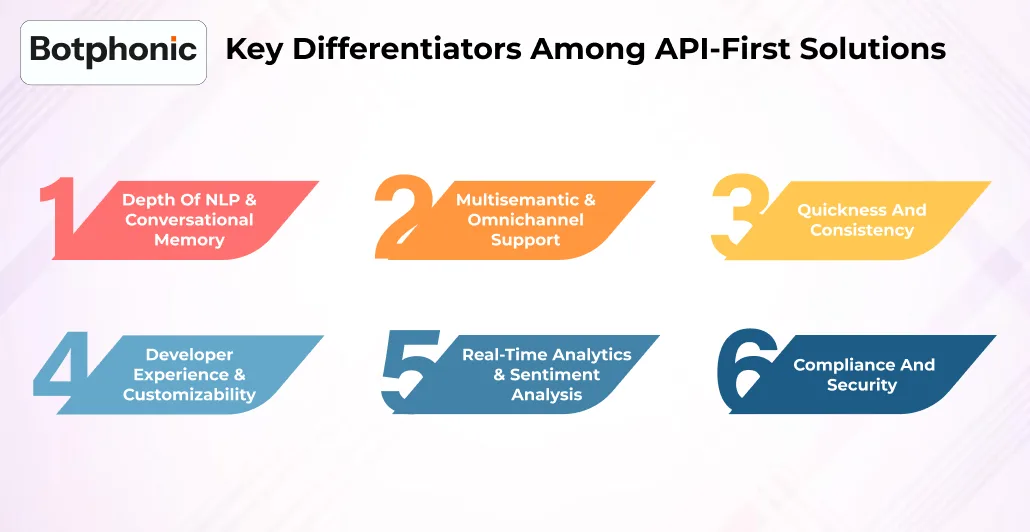
API-first conversational AI platform are not all the same. In this, businesses ought to consider them based on the following differentiators:
1. Depth of NLP & Conversational Memory
The advanced platforms do not forget the context between sessions and make the interactions more human-like.
2. Multisemantic & Omnichannel Support
Its customers are distributed globally, which means that platforms supporting a multi-lingual and multi-channel (voice, chat, social media) offer obvious benefits.
3. Quickness and Consistency
High uptime and low latency are essential in call centre deployments using AI, where latency damages credibility amongst customers.
4. Developer Experience & Customizability
SDKs: Webhook and rich documentation help the developers create innovative things fast.
5. Real-Time Analytics & Sentiment Analysis
Businesses also find it beneficial to use dashboards that can capture things such as customer mood, call duration and intent success rates.
6. Compliance and Security
In businesses such as healthcare and finance, the requirement to adhere to standards, such as GDPR and HIPAA, is not negotiable.
The Gartner estimates that generative AI will be used by 80 percent of customer service organisations by 2025. This supports the heavy investment in AI call assistants and API-first setups by businesses.
Core Features of Top API-First Conversational AI Platforms
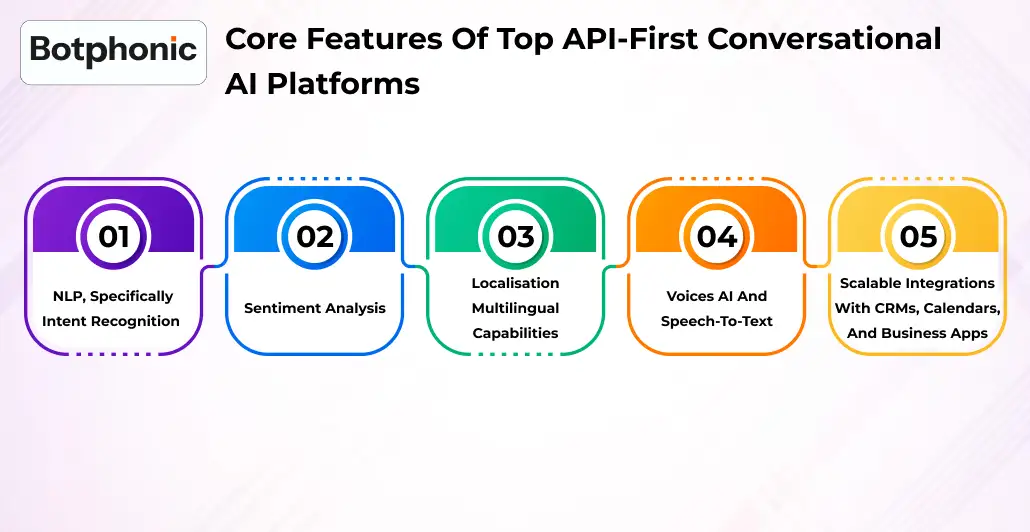
Any robust API-first conversational AI platform is equipped with capabilities that will prove to be useful in any industry. The following are some of the most significant:
1. NLP, Specifically Intent Recognition
NLP makes bots interpret human queries accurately, whereas intent recognition provides a mapping of queries towards the respective responses.
2. Sentiment Analysis
Taking it another step further, improved AI technology may recognise the tone and emotion, which will make AI call attendants more sensitive.
3. Localisation Multilingual Capabilities
This is important to businesses with ambitions of being inclusive and extending their reach to key regions of the globe.
4. Voices AI and Speech-to-Text
Important to the AI-based call centres, where each bot would be able to respond to both text and voice.
5. Scalable Integrations with CRMs, Calendars, and Business Apps
These plug-and-play APIs enable businesses to integrate with Salesforce, HubSpot, Outlook and so forth.
Use Cases & Vertical Applications
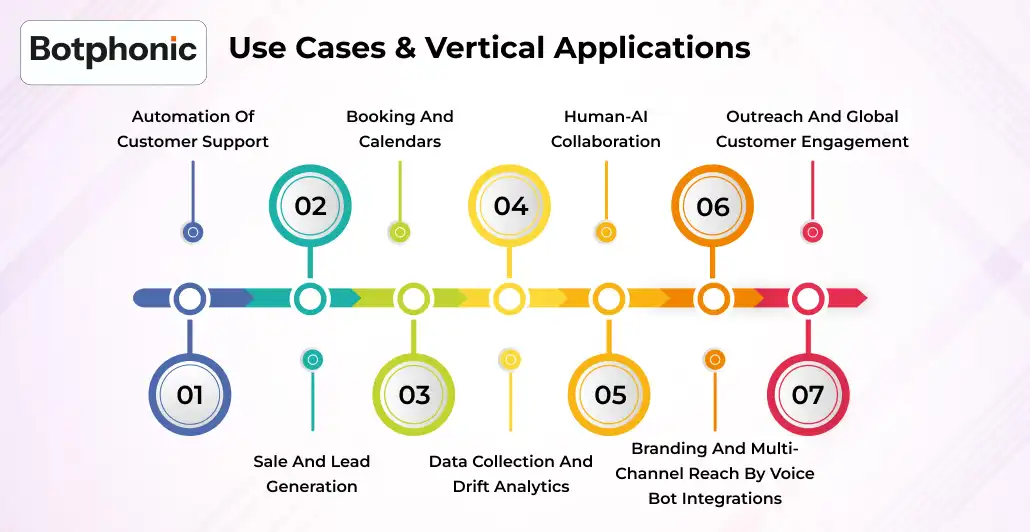
An effective API-first conversational AI can be used across various industries. These are some sample usability:
1. Automation of Customer Support
AI call assistants will be able to answer typical questions raised by customers in a matter of seconds, rather than having to wait. In an e-commerce scenario, a bot could be used to provide real-time updates on order status, returns, and delivery.
2. Sale and Lead Generation
Intelligent questions can be used to qualify the leads and then pass the warm prospects to natural human agents in the AI call centre. It lowers the pressure on the sales reps and increases conversion speed.
3. Booking and Calendars
AI call assistants can be utilised by healthcare providers, salons, and consulting firms to schedule and reschedule appointments, sync calendars, and even send reminders.
4. Data Collection and Drift Analytics
Companies can easily capture post-interaction feedback, which transforms conversations into a measurable bit of information.
5. Human-AI Collaboration
Artificial intelligence does not substitute for a human; it assists them. In AI call centres, the agents can depend on bots to propose responses, retrieve knowledge base articles, and auto-summarise calls.
6. Branding and Multi-channel Reach by Voice Bot Integrations
Banks and retail companies may implement branded voice bots into their IVR systems that provide customers with a uniform and professional experience.
7. Outreach and Global Customer Engagement
A multilingual AI call assistant can remove language barriers, supporting customers in English, Spanish, Hindi, and regional dialects, and enabling businesses to expand globally.
The Future of API-First Conversational AI
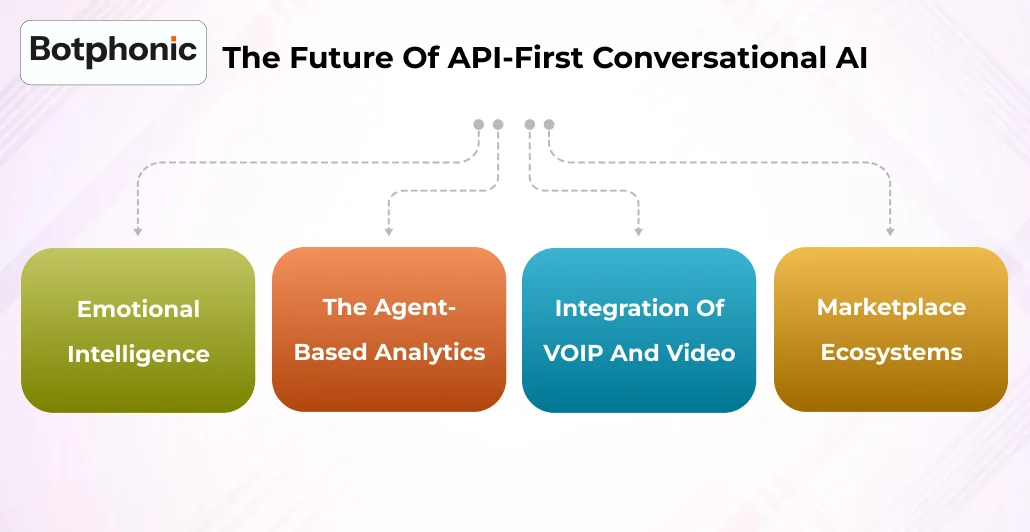
The dynamic, flexible, and hyper-personalised conversational AI will define the future. These are some of the new trends:
1. Emotional Intelligence
The call assistants of the next generation will not only recognise words but also emotions, emulating compassion or enthusiasm depending on the state of the customer.
2. The Agent-Based Analytics
Instead of reacting, bots will predict what the customers will want, such as automatically issuing a refund when the delivery has been delayed.
3. Integration of VOIP and Video
In addition to the text and voice, possible future platforms can offer video-powered chatbots, perfectly suitable as a virtual consultation form.
4. Marketplace Ecosystems
Similar to app stores, there will be AI bot markets too, where companies will buy and sell or mix-and-match ready-to-use conversational units.
Discover how Botphonic AI can help you build smarter, scalable, and customizable AI solutions for your business.
Request a Free DemoConclusion
Due to the migration to API-first conversational AI-based tools, there is a new era of business automation. With the APIs as a point of focus, the companies will have gained flexibility, scale, and long-term adaptability.
They can be used in call centres that use AI, as well as call assistants personalised by AI; the possibilities are endless. Those companies that go early will not only save costs but also open up possibilities of new forms of customer engagement and innovation.

